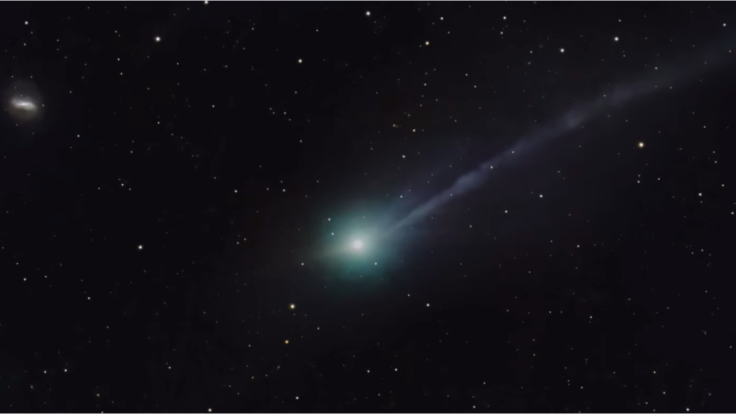3I/ATLAS Update: Avi Loeb Spots 13th Anomaly Suggesting Comet May Be Targeting Jupiter
Avi Loeb spots a 13th anomaly suggesting interstellar visitor 3I/ATLAS is targeting Jupiter.

Is it a cosmic iceberg adrift in the void, or a calculated visitor with a mission? The silence of the outer solar system was broken on July 1, 2025, when the ATLAS telescope in Rio Hurtado, Chile, detected a third traveller crossing the threshold of our star system. Unlike its predecessors, 'Oumuamua and Borisov, this object—designated 3I/ATLAS—has ignited a firestorm of debate that transcends standard astronomy.
While official channels classify it as a comet, Harvard astrophysicist Avi Loeb has spotlighted a series of 'extraordinary' anomalies, culminating in a disturbing mathematical coincidence: the object appears to be navigating with precision toward Jupiter. Is this nature's dice roll, or is 3I/ATLAS an artificial probe 'phoning home?'

Unveiling the Cosmic Visitor: The Discovery of 3I/ATLAS
The initial detection of 3I/ATLAS was a triumph for the Asteroid Terrestrial-impact Last Alert System (ATLAS). Bolstered by pre-discovery observations from June 14, 2025, via Caltech's Zwicky Transient Facility, astronomers quickly confirmed the object was unbound by the Sun's gravity. It was hurtling from the depths of interstellar space with a hyperbolic excess velocity of approximately 60 km/s.
While NASA's official page assures the public that 3I/ATLAS poses no threat to Earth—passing at a safe minimum distance of about 1.8 astronomical units (roughly 270 million kilometres)—its behaviour has been anything but typical. Its perihelion on October 30, 2025, brought it just inside the orbit of Mars at 1.35 AU. This proximity allowed for an unprecedented observational campaign. Beyond Hubble and JWST, the object was scrutinized by a fleet of solar system assets.
NASA's Psyche and Lucy spacecraft captured images en route to their asteroid targets, while the STEREO-A spacecraft's Heliocentric Imager-1 managed to detect the comet despite the sun's glare. Even Mars-based assets joined the hunt: the MAVEN orbiter detected a hydrogen envelope using ultraviolet filters, while the Mars Reconnaissance Orbiter's HiRISE camera resolved the object as a distinct 'fuzzy white ball', and the Perseverance rover snapped it as a faint smudge from the Martian surface.
From the teardrop-shaped dust cocoon captured by the Hubble Space Telescope to the spectral analysis by the James Webb Space Telescope (JWST) revealing a bizarre composition of only 4% water and high carbon dioxide, 3I/ATLAS has consistently defied the standard profile of a 'dirty snowball' comet. Visually, it remains a fuzzy, elongated streak, teasing observers with prominent jets that seem to resist the chaos of rotation.

Decoding the Enigma: A Catalogue of Anomalies
Avi Loeb has argued that the cumulative improbability of 3I/ATLAS's features—a product of individual likelihoods yielding odds below $10^{-10}$—demands we consider artificial origins. Avi Loeb has spotlighted a series of anomalies that challenge natural explanations. The list of peculiarities is extensive and baffling:
- Orbital Precision: Its retrograde trajectory aligns within 5 degrees of the ecliptic plane (a 0.2% likelihood), facilitating easy access to the planets.
- The Anti-Tail: In July, August, and November 2025, the object developed a sunward 'anti-tail'. Unlike optical illusions seen in other comets, this feature suggests directed propulsion or exhaust.
- Mass and Composition: The nucleus is massive—roughly one million times that of 'Oumuamua with an estimated mass of over 33 billion tons—yet the plume is dominated by CO2 ice with a high nickel-to-iron ratio similar to industrial alloys.
- The 'Wow!' Connection: The object's incoming direction aligns within 9 degrees of the mysterious 1977 'Wow! Signal', a potential breadcrumb trail to its origin.
- Physics-Defying Jets: Tightly collimated jets maintain a straight orientation over 1 million kilometres, defying the object's 16.16-hour rotation. New stacked images from late November reveal these jets form two thin, ruler-straight lines running perpendicular to the Sun-object axis, creating an uncanny 'X' shape with the tail and anti-tail that Loeb argues resembles the wake of smaller craft peeling away from the main body.
- Optical Oddities: The object has shown extreme negative polarization—a phenomenon unprecedented in comets (<1% likelihood)—suggesting its surface may be coated in artificial materials rather than natural dust. Furthermore, near perihelion, 3I/ATLAS brightened rapidly and appeared distinctly bluer than the Sun, implying an internal heat source far hotter than the solar photosphere.

The Jupiter Connection: Is 3I/ATLAS Targeting the Gas Giant?
The most unsettling piece of the puzzle is the 13th anomaly. Loeb notes that during its perihelion—while hidden behind the Sun—3I/ATLAS experienced a non-gravitational push ($5times10^{-7}$ AU/day²). This was not a random tumble. According to JPL Horizons data, this specific acceleration adjusted the object's trajectory to bring its closest approach to Jupiter on March 16, 2026, to exactly 53.445 million kilometres.
This distance is statistically shocking because it matches Jupiter's Hill radius (53.502 million kilometres) within a margin of just 0.06 million kilometres. The Hill radius is the gravitational boundary where a planet can capture a moon or a probe. Loeb suggests this 'extraordinary coincidence' (1 in 26,000) implies a 'Jupiter Oberth manoeuvre'. If 3I/ATLAS is a mothership, it could be using this manoeuvre to deploy smaller probes or 'seeds' into Jupiter's orbit with minimal energy, potentially to observe the gas giant—a target visible from billions of light-years away.
The Great Debate: Natural Phenomenon or Alien Technology?
The scientific community remains divided. In a July 2025 Harvard paper, Loeb and his collaborators modelled the object as a potential craft capable of deploying probes detectable by future missions. He speculates that aliens might prioritise gas giants over Earth, delivering an 'ego blow' to humanity's self-importance. Conversely, mainstream astronomers and Reddit discussions argue that 3I/ATLAS is simply an 'unfamiliar interstellar iceberg', likely formed in a distant system's carbon-rich outer disk.
NASA officials, including Associate Administrator Amit Kshatriya, have vehemently denied the alien hypothesis, stating firmly that 'it behaves like a comet' and citing the lack of clear technosignatures. While some dismiss Loeb as a 'grifter' on social media platforms like X, others are glued to JPL updates, waiting to see if Jupiter's orbit reveals new, artificial moons after 2026. With the object scheduled to make its closest pass to Earth in mid-December, astronomers are preparing for one final, close-range look that could settle the debate once and for all. Until then, the silence of 3I/ATLAS speaks volumes.
The universe rarely yields its secrets easily, and 3I/ATLAS is proving to be a masterclass in cosmic ambiguity. Whether this visitor is a dormant relic from a dead star system or a technological marvel executing a precision manoeuvre, its presence has irrevocably altered our understanding of what lies in the interstellar void. As telescopes around the globe pivot for the critical mid-December observations, the world holds its breath for what could be the definitive answer to the ultimate question: are we alone?
© Copyright IBTimes 2025. All rights reserved.




















